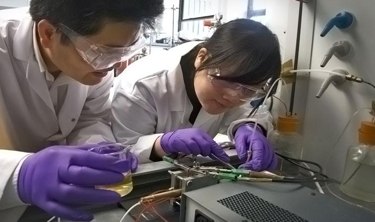 Researchers have figured out a way to make the world’s first urine-powered fuel cells — a significant feat, because most fuel cell systems today are too costly to be a source for renewable energy or allow for easy commercial use, especially in poorer developing countries. And, they’re safer too. Fuel cells usually rely on flammable hydrogen gas or toxic methanol to generate electricity.
Researchers have figured out a way to make the world’s first urine-powered fuel cells — a significant feat, because most fuel cell systems today are too costly to be a source for renewable energy or allow for easy commercial use, especially in poorer developing countries. And, they’re safer too. Fuel cells usually rely on flammable hydrogen gas or toxic methanol to generate electricity.
Chemistry researchers at Heriot-Watt University’s School of Engineering and Physical Sciences in Edinburgh have developed a cheaper prototype that instead relies on the organic compound urea to create electricity and clean water.
Urea is a mass-manufactured industrial fertilizer as well as a major component of human and animal urine. Dr. Shanwen Tao thought about incorporating urea because he had seen it used as a fertilizer while growing up in eastern China.
The Carbamide Power System prototype created by Tao and his research partner Dr Rong Lan can break down urea or urine into its component parts — water, nitrogen and CO2 — while producing electricity at the same time.
The Carbamide System (carbamide is another word for urea) would thus offer a non-toxic, low cost, easily transportable viable alternative to high pressure, highly flammable hydrogen gas or the toxic methanol currently used in fuel cells.
The University reports that a urea solution is already being used in heavy vehicles to reduce nitrous oxide emissions, so a global fuelling infrastructure already exists.
Dr Tao believes that long term potential applications of the Carbamide Power System include use in submarines, power generation on remote locations such as deserts or islands and as a water treatment method for municipal sewage, since the process breaks the Urea or urine into water — with electricity as a by product.
Awarded this year with a $203,000 grant (£130,000), the team in Scotland is optimizing the fuel cell in preparation for further investment or technology licensing.
For more information, or to contact the group, visit the University’s Youtricity blog.



















